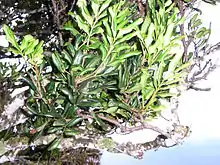| Guioa coriacea | |
|---|---|
 | |
| Scientific classification | |
| Kingdom: | Plantae |
| Clade: | Tracheophytes |
| Clade: | Angiosperms |
| Clade: | Eudicots |
| Clade: | Rosids |
| Order: | Sapindales |
| Family: | Sapindaceae |
| Genus: | Guioa |
| Species: | G. coriacea |
| Binomial name | |
| Guioa coriacea | |
| Synonyms | |
| |
Guioa coriacea , commonly known as cedar or island cedar, is a flowering plant in the family Sapindaceae. The specific epithet refers to the coriaceous (leathery) leaves.[1]
Description
It is a tree growing to 15 m in height. The shiny paripinnate leaves, with under-rolled edges and 1–4 pairs of leaflets, are 30–110 mm long, 12–50 mm wide. The white, tinged pink, 6 mm long flowers occur in clusters from December to February. The fruits are green-brown, 3-lobed woody capsules, 25 mm long. The small black seeds are 1–1.5 mm long and covered with a fleshy orange aril. The trees are often noticeable in early winter because of the orange arils on the seeds that have fallen to the ground.[1][2]
Distribution and habitat
The species is endemic to Australia’s subtropical Lord Howe Island in the Tasman Sea where it is common in sheltered lowland forest.[1][2]
References
- 1 2 3 4 " Guioa coriacea ". Flora of Australia Online: Data derived from Flora of Australia Volume 49 (1994). Australian Biological Resources Study (ABRS). Retrieved 2014-02-23.
- 1 2 Hutton, Ian (1998). The Australian Geographic Book of Lord Howe Island. Sydney: Australian Geographic. p. 145. ISBN 1-876276-27-4.
External links
- "Guioa coriacea (Radlk.) Radlk". Atlas of Living Australia.